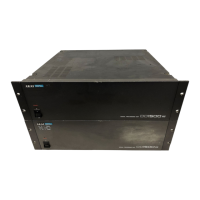25 - DD1000 DISK COMPATIBILITY
Page 274 Version 2.00 - November, 1994
PLAYING DD1000 DISKS CREATED ON A DD1500 ON A DD1000
Some degree of backwards compatibility is also possible between the DD1500 and
DD1000 and any DD1000 disks you have worked with on the DD1500 may still be used on
a DD1000.
Recordings can be made on the DD1500 to a DD1000 disk in the usual manner (i.e.
select a track for record, press PLAY+RECORD) but the DD1500 uses the following rules
to decide whether a recording is mono or stereo when recorded on a DD1000 disk.
• Adjacent channel pairs of tracks enabled for record are recorded as DD1000 stereo
takes.
• Non-adjacent and remaining channels are recorded as DD1000 mono takes.
1
2
3
4
5
REC ENABLE track = 2
REC ENABLE tracks = 2+3
REC ENABLE tracks = 2+4
REC ENABLE tracks = 2+3+4+5
REC ENABLE tracks = 1+2+3+9+10
2 = MONO
2 + 3 =STEREO
2 = MONO, 4 = MONO
2 + 3 = STERE0, 4 + 5 = STEREO
1 + 2 = STEREO, 3 + MONO,
9 + 10 = STEREO
NOTE 1: When recording in stereo, the first track of the pair is always assigned to the left
channel of the DD1000. For example, in example number 2 above, track 2 would be
assigned to the left channel and track 3 to the right.
NOTE 2: If two mono recordings are assigned to a stereo pair, it will not be phase
coherent on the DD1000.
When recording on the DD1500 is finished, the DD1500 stores extra cuts files and record
settings to allow this backwards compatibility.
You will also note the way DD1000 take names are created by the DD1500. The ten-
character take names are formed as follows:
CLIP12 998
ABC
A The first four characters are the recording name
B These show the track number the recording was made on
C This is a unique identifier to create a totally unique take name

